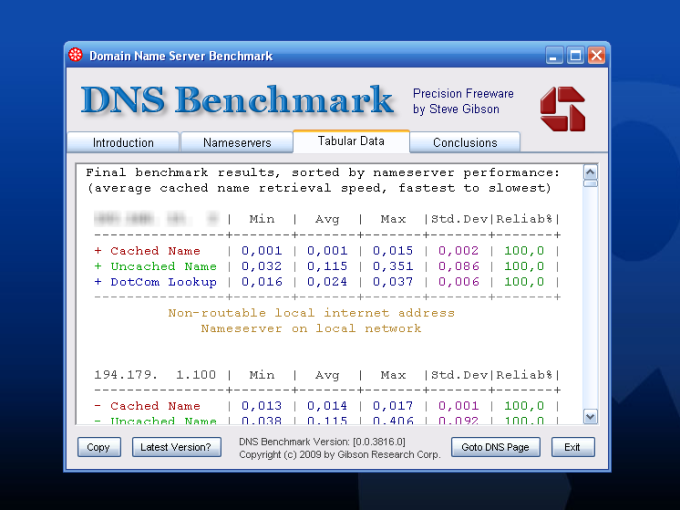
It can also verify the security of the DNS nameservers and provide DNSSEC (Domain Name System Security Extensions) authentication. It checks the performance of up to DNS servers, providing a comprehensive analysis of all the servers.
#DNS BENCHMARK WINDOWS#
It is compatible with Windows and can be used on Linux and MacOS using Wine ( Windows Emulator).
#DNS BENCHMARK DOWNLOAD#
You can download and start using it without installation. GNC’s DNS Benchmark is a lightweight software.
#DNS BENCHMARK SOFTWARE#
This tool shows the minimum response time, average response time, maximum response time, reliability and standard deviation of the DNS servers.ĭNS Benchmark is a reliable software used by professionals. This utility tool provides its user a detailed report about the DNS server, enabling the user to find the suitable DNS server. It has a neat and simple UI that can be easily used by complete beginners. SupportedĬonfiguration Guidance: Enable resource logs for the Azure DNS service.Developed by Gibson Research Corporation, DNS Benchmark is one of the best DNS benchmarking tools available on the internet. The customer can configure these resource logs and send them to their own data sink like a storage account or log analytics workspace. Reference: Overview of Microsoft Defender for DNS LT-4: Enable logging for security investigation Features Azure Resource Logsĭescription: Service produces resource logs that can provide enhanced service-specific metrics and logging. SupportedĬonfiguration Guidance: Use Azure Defender for DNS to monitor queries and detect suspicious activities with the need of agents on your resources.

LT-1: Enable threat detection capabilities Features Microsoft Defender for Service / Product Offeringĭescription: Service has an offering-specific Microsoft Defender solution to monitor and alert on security issues. Reference: Azure Policy built-in definitions for Azure networking services Logging and threat detectionįor more information, see the Microsoft cloud security benchmark: Logging and threat detection. Use Azure Policy and effects to enforce secure configuration across Azure resources. Use Azure Monitor to create alerts when there is a configuration deviation detected on the resources. SupportedĬonfiguration Guidance: Use Microsoft Defender for Cloud to configure Azure Policy to audit and enforce configurations of your Azure resources. AM-2: Use only approved services Features Azure Policy Supportĭescription: Service configurations can be monitored and enforced via Azure Policy. Reference: Azure role-based access control Asset managementįor more information, see the Microsoft cloud security benchmark: Asset management. Azure RBAC roles can be assigned to users, groups, service principals, and managed identities. SupportedĬonfiguration Guidance: Use Azure role-based access control (Azure RBAC) to manage Azure resource access through built-in role assignments.

PA-7: Follow just enough administration (least privilege) principle Features Azure RBAC for Data Planeĭescription: Azure Role-Based Access Control (Azure RBAC) can be used to managed access to service's data plane actions. Privileged accessįor more information, see the Microsoft cloud security benchmark: Privileged access.

SupportedĬonfiguration Guidance: This feature is not supported to secure this service. IM-1: Use centralized identity and authentication system Features Local Authentication Methods for Data Plane Accessĭescription: Local authentications methods supported for data plane access, such as a local username and password. NSGs contain a list of Access Control List (ACL) rules that allow or deny network traffic to your subnet.įor more information, see the Microsoft cloud security benchmark: Identity management.

Protect your subnet from potential threats by restricting access to it with a Network Security Group (NSG). Subnets should be associated with a Network Security Group Microsoft Defender for Cloud monitoringĪzure Policy built-in definitions - Microsoft.Network: Name (Azure portal) Supportedįeature notes: The Azure DNS Private Resolver service deploys endpoints within customer Azure Virtual Networks which is in a preview state.Ĭonfiguration Guidance: This feature is not supported to secure this service. NS-1: Establish network segmentation boundaries Features Virtual Network Integrationĭescription: Service supports deployment into customer's private Virtual Network (VNet). Service can be deployed into customer's virtual networkįor more information, see the Microsoft cloud security benchmark: Network security. The security profile summarizes high-impact behaviors of Azure DNS, which may result in increased security considerations.
#DNS BENCHMARK FULL#
To see how Azure DNS completely maps to the Microsoft cloud security benchmark, see the full Azure DNS security baseline mapping file. Features not applicable to Azure DNS have been excluded.


 0 kommentar(er)
0 kommentar(er)
